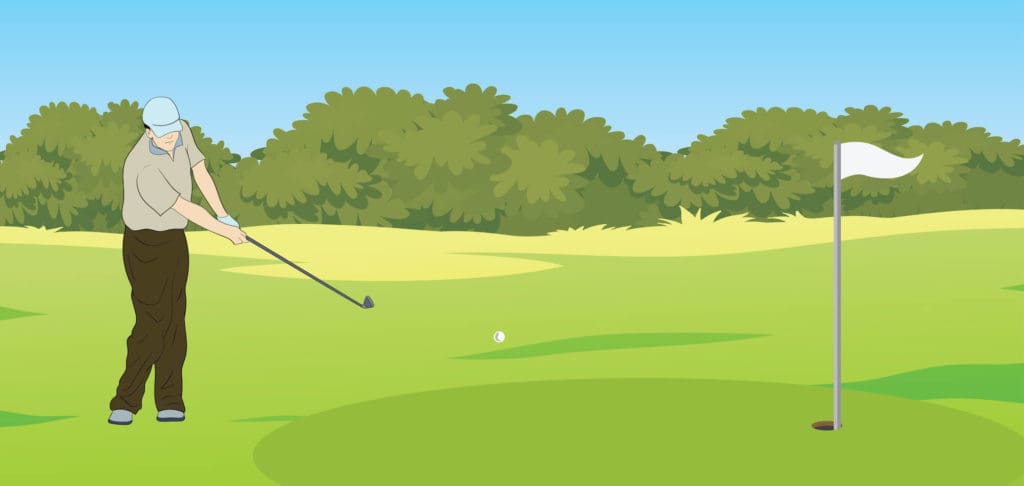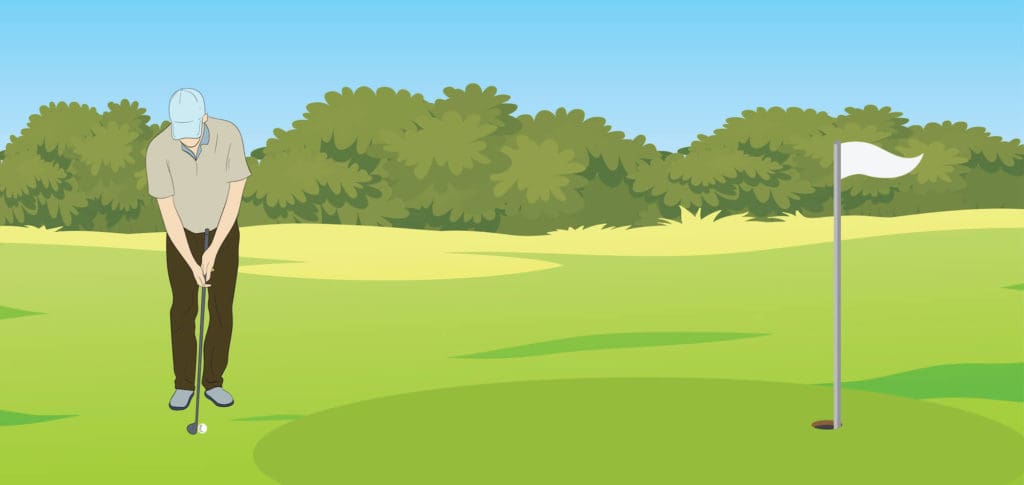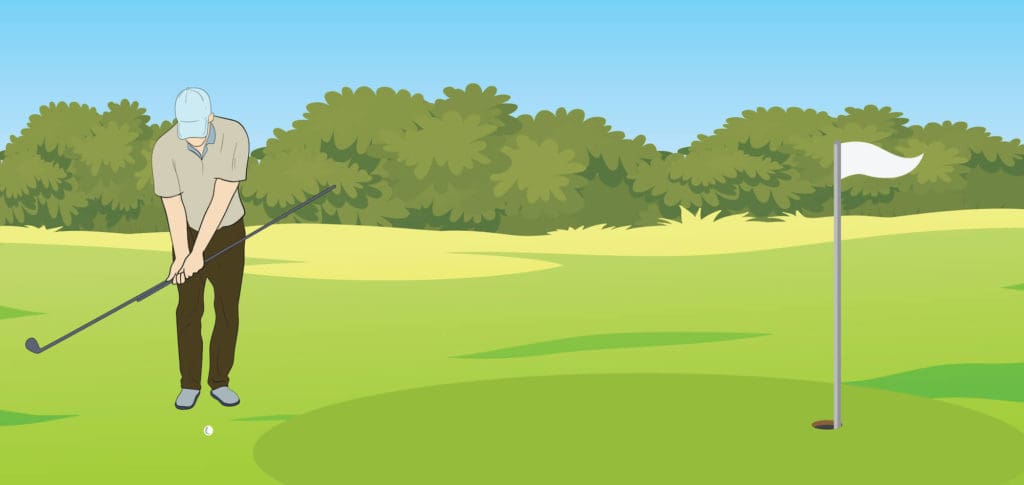The bump and run is a skill you need to develop to succeed in golf. The mistake that most beginners make is thinking that the driver is all you need. While you need the power, distance, and accuracy that the driver provides, it is only one piece of the puzzle. Ask any professional player, and they’ll tell you how important it is to have solid ability around the green.
That means that you’ll spend most of your practice hitting within 100 yards if you want to keep hitting high-quality shots. Scoring those crucial six-foot distances will help you rank higher in your games. Practicing your bump and run is the way to do that.
What is the Bump and Run?
The bump and run is a type of chip shot typically used by high handicap golfers. The goal is to keep the ball low by bumping it. From there, the ball should run across the green towards the hole. It requires less motion with the club compared to other chip shots. You’ll need to be careful with the swing and its contact to achieve a clean bump and run.
You want to use this move when you’re around the side of the green or close to it. You want it to roll uninterrupted. Most players use it in these areas because it’s easier to control your speed. You can also use the technique when near a wooded area, so you don’t end up hitting branches that could stop your ball’s path.
Why Use a Bump and Run Rather Than a Chip Shot?
The bump and run has more favorable outcomes with larger spaces between you and the hole. It’s best to use if you know you’re moving the ball across a large green. Here are some reasons you’d want to bump and run:
- You’re in a spot that has a lot of trees. Obstructions like these can stop your ball’s path when you send it flying. It’s common to hit a branch and miss the green entirely if you try your usual chip shots.
- The wind is too strong, and it might influence your shot. You’ll notice how wind affects your ball, especially if you frequent European courses. The bump and run will remove wind from the equation.
- There is very little grass underneath the ball (tight lies). It’s close to the green, but the lack of grass may make it hard to hit the shot. Another scenario is when you find yourself in a hard dirt spot.
- You’re playing on a links golf course. These have sandy coastland, which is more favorable for the bump and run. You often find these courses in Scotland.
The bump and run are often easier for beginners to master, even though not many use it down the line. The reason for that is that most do not favor it because of the terrain. Pros often play at a higher elevation, making it difficult for them to use the bump and run. However, for your early forays into the golf course, it may be just the thing you need to tackle flat approaches.
Rigid motion is necessary to hit your shots consistently with the movement. Since it’s harder to judge your swing when starting, you may want the bump and run rather than relying on your wedge. It’s easier to ascertain the speed of the ball using it, and you won’t have to account for your strike that much.
What Club Should I Use?
Most golfers that use the bump and run often use 8 or 9 irons (this is my preference). Sometimes, they’ll use a pitching wedge, but I feel that the PW has too much loft for this shot. They use these clubs because it makes it easy to control the speed and direction of the ball. You’ll keep it low enough to stay away from obstacles while still providing the accuracy you need.
I’ve heard of some people using a three wood, but I have yet to try it. You’ll need to figure out your preference as you’re practicing.
As a general rule, you want something with less loft. There is no wrong answer as long as you can hit the shot. You want to ensure the club is enough to achieve the travel you want with the ball.
How Do I Hit a Bump and Run Golf Shot?
When you’re preparing for a bump and run shot, place the ball back in your stance. Put your weight on your front foot and lock your elbows. Look at the area you want to land the ball. Swing your arms back and forth like a putt, bumping the ball, allowing it to run towards the hole. You do not want it to fly.
The fundamentals are essential here. You need to look out for several things while doing the bump and run.

First, keep your weight on your lead leg. This is a fundamental move for all chip shots. For the bump and run, it ensures you’re going to do a downward stroke on the ball.
Placing the ball on the inside of the back foot causes the club to make contact so it shoots lower. If you play it too forward, you’ll end up hitting it without too much power.
Your arm swing should be a pendulum, similar to how you would do a putt. You don’t want to use your wrist and make the ball fly through the air.
The bump and run feel stiff, but it’s because your shoulders are doing the movement. That way, you ensure that the ball moves in the direction you want it to go. You’ll make the ball travel farther when you place your backswing higher. When you’re practicing, focus on acceleration.
Tips to Use When Hitting a Bump and Run
Unlike your typical greenside shot, you want to move your shaft, making it more vertical. Put the toe down and stand the shaft up. You want to practice this form and hit the ball as aggressively as possible. It will allow you to see how far it can go depending on your strength.
Pros also agree that you should put the ball in the back of the stance. Doing this will make the shot feel better and ensure you hit the ball first. The toe position is so that you avoid putting a backspin on the ball. Playing the ball towards the toe prevents that, making it look like a putt.

When practicing your bump and run, you cannot hesitate. Overthinking the shot will cause it to spin too much. When you’re confident, you hit it the way you want.
Bump and Run Drills
There are several movements to help you learn your bump and run shots. Here are the drills you can use during practice:
Drill 1
Take two alignment sticks or poles and stick them to the ground. They should be 5 to 10 feet in front of you. You can tie a rope between the two, enough so the ball can pass underneath it to ensure you’re getting the bump and run. Do this multiple times as practice.

Another thing you can do is add another target for you to hit beyond the poles. Imagine it as the whole area you want your shot to travel. Setting it farther out allows you to practice the distance of your hit.
Take it a step further by using different clubs but maintaining your swing. You’ll see how the ball reacts when you change clubs. You’ll add more versatility to your bump and run this way.
Drill 2
Take an old shaft or alignment stick and put it at the butt-end of your grip. Try to hit some shots with it. Be careful not to bend your wrists too much or you’ll end up hitting yourself. The goal is to ensure that your wrists don’t interfere with your swing. You want to turn your body out of the way to create the proper movement.

Putting It All Together
You don’t see the bump and run often in professional play. However, that does not mean that most golfers don’t have it in their arsenal. There is still a place for the bump and run, whether you’re planning to hit a tour or not.
However, with every technique you develop, you must practice it often. You should be able to hit the ball without worrying about the shot when you’re playing. When you try to use the technique unprepared, you’re likely to get more anxious. You must put work into the bump and run to succeed. Practice makes perfect.
